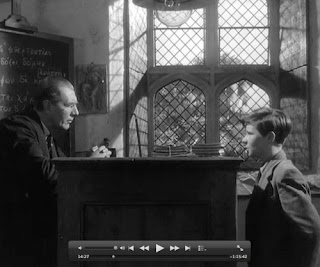Students in ClCv241 would be well advised to avoid writing on Orestes in Hamlet. The connection fails, in my judgment, on the grounds of insufficient corroborating evidence.
Much more promising is analysis of Shakespeare's usage of Priam's death in Hamlet. That usage has everything going for it: overt allusion, thematic cohesion, secondary scholarship to underpin it. Sample Paper. Approve: OGCMA1050TrojanWarTroyFall_Shakespeare
Reid's inclusion of Hamlet in the Orestes article is problematic. As an appellate judge, I overrule Reid's choice, allowing comparisons of Hamlet's plight (and plot) to Orestes' on archetypal levels, but not as usage.
Reid is not at all alone in her inclusion of Hamlet into the Orestes tradition. Here is a statement by Erich Segal, to which I feel some resistance. Interjecting commentary in O'Neill's Mourning Becomes Electra, Segal elucidates Orin's murder of Brant thus:
The avenger has accomplished his traditional task. His father’s murder lies dead. Now it’s at this point that the Orestes myth was open to some variation, for of course the murderous queen still lives. Christine Mannon sits quietly at home. In the Odyssey Homer is reticent about it. In fact, he nearly ducks the issue, merely noting that after her lover was killed, Clytemnestra died, … of grief perhaps. But in the Aeschylus trilogy, matricide becomes the central moral issue. Orestes hesitates momentarily before killing his mother, but does so when he is reminded that it is his sacred duty. Armed with a sense of divine justice, he doesn’t even stop when Clytemnestra bears her breast to him in a plea for mercy. Later heroes have their doubts. Hamlet is in torment as he heads for the chamber of his adulterous mother, “Let me speak daggers, but use none,” he says, almost as a prayer. But here is where O’Neill completely abandoned every trace of tradition. The Oedipal ambivalence at which Shakespeare strongly hints is here let loose from the prison of the unconscious. ...”
——
E. Segal, “Afterword [to episode III, or DVD disc 2, chapter 9]” on Eugene
O’Neill’s Mourning Becomes Electra,
dir. by Nick Havinga (Thirteen/WNET New York, Great Performances, 1978; distributed
2001 by Image Entertainment Corp.
My objection in using the Hamlet to elucidate the Oresteia is that Shakespeare's revenge tragedy is not actually a usage of the classical myth. Narrative and structural parallels notwithstanding, I do not consider Hamlet part of this tradition.
Circumstantial only...
L. Schleiner, "Latinized Greek Drama in Shakespeare's Writing of Hamlet," Shakespeare Quarterly 41 (1990): 29 - 48 ... despite its fine scholarship....
-->
Nicholas Rowe in
1709 (N. Rowe, Life of Shakespeare
(1709), in CR 1:30-1) saw similarities btwn Orestes and Hamlet: “Hamlet is founded upon much the same
Tale with Electra of Sophocles.”
(ref. in M. de Grazia, Hamlet without
Hamlet (Cambride UP 2007) p. 11), but Shakespeare’s avenger manifests
greater decorum re: “the rules of manner proper to Persons.” de Grazia recounts
the “debate over the Orestes/Hamlet parallel” that began with Rowe’s
observation and extended through the 18th century
J.G. Herder saw
Hamlet as a “thoughtful Orestes” (ref. in M. de Grazia, Hamlet without Hamlet (Cambride UP 2007) p. 20): see H. H. Furness,
ed., Hamlet Variorum edn. 2 vols.
1877 (Dover facsimile edition of 1963), II.276-78.
Schlegel discussed
Hamlet/Orestes to illustrate the classical/romantic binarism (ref. in M. de
Grazia, Hamlet without Hamlet
(Cambride UP 2007) p. 20: see H. Eichner, Friedrich
Schlegel (New York: Twayne, 1970), 25
Against this I offer G. Murray, "Hamlet and Orestes," in The Classical Tradition in Poetry, the Charles Eliot Norton Lectures (Harvard 1930): 205 - 40. OGCMA0763_ShakespeareMurray
Gilbert Murray argues, as a classicst would, that Shakespeare's unfamiliarity with Greek literature prevented him from linking the tale of Hamlet to the myth of Orestes.
Just thinking.








